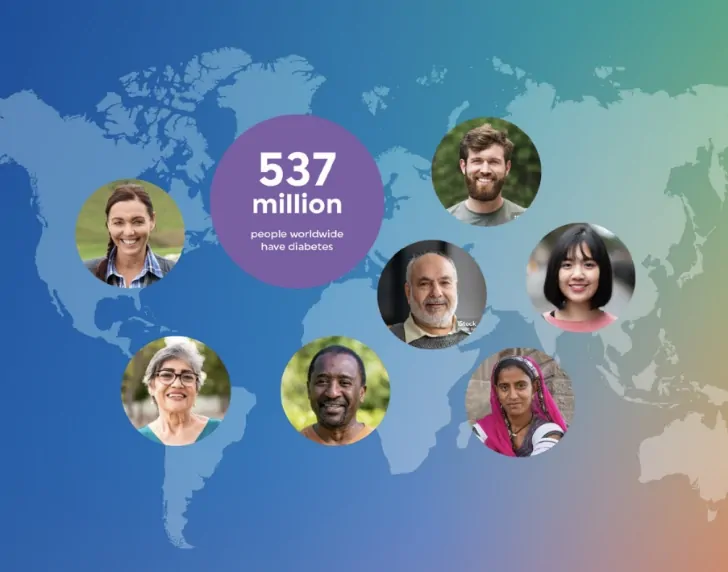North America and Caribbean
Diabetes regional report 2000 — 2050
Number of adults (20–79 years) with diabetes in North America and Caribbean (NAC)
| 2000 | 21.4 million |
| 2011 | 37.7 million |
| 2024 | 56.2 million |
| 2050 | 68.1 million |
Estimates for Canada, Mexico, the USA and 22 Caribbean countries and territories in the IDF North America and Caribbean (NAC) Region. Estimates for diabetes in adults in the Region were based on 21 data sources, representing 15 of the 22 countries. Estimates for Mexico and USA were based on studies conducted within the past five years.
The Region has the second highest diabetes prevalence among IDF Regions at 15.1%. IDF projects that the number of people with diabetes in the Region will increase by 22%, to reach 68 million by 2050. The Region has the second highest number of people with type 1 diabetes – 1.9 million in total. The NAC Region has the highest proportion (21.4%) of diabetes-related mortality to all-cause mortality and the second highest number of deaths due to diabetes (526,000) among IDF Regions. The Region has the highest diabetes-related expenditure (USD 439 billion), 43% of global expenditure, and has the highest average cost per person with diabetes (20–79 years) at USD 7,811.
| Diabetes estimates (20-79 y) | ||||
|---|---|---|---|---|
| People with diabetes, in 1,000s | 21,375.1 | 37,700.0 | 56,196.4 | 68,102.9 |
| Age-standardised prevalence of diabetes, % | 7.8 | 10.7 | 13.8 | 15.3 |
| Proportion of people with undiagnosed diabetes, % | - | - | 29.1 | - |
| People with undiagnosed diabetes, in 1,000s | - | - | 16,346.5 | - |
| Impaired Fasting Glucose (IFG) | ||||
|---|---|---|---|---|
| People with IFG, in 1,000s | - | - | 53,025.9 | 61,578.5 |
| Age-standardised prevalence of IFG, % | - | - | 13.6 | 14.3 |
| Impaired Glucose Tolerance (IGT) | ||||
|---|---|---|---|---|
| People with IGT, in 1,000s | - | 36,900.0 | 46,614.8 | 55,325.0 |
| Age-standardised prevalence of IGT, % | - | 10.7 | 11.6 | 12.6 |
| Mortality attributable to diabetes (20-79 y) | ||||
|---|---|---|---|---|
| Deaths attributable to diabetes | - | 280,800.0 | 526,029.9 | - |
| Proportion of diabetes-related deaths in people 20-79 y, % | - | - | 21.4 | - |
| Hyperglycaemia in pregnancy (HIP) (20-49 y) | ||||
|---|---|---|---|---|
| Live births affected by HIP | - | - | 1,379,325.9 | - |
| Prevalence of gestational diabetes mellitus (GDM), % | - | - | 17.9 | - |
| Live births affected by other types of diabetes first detected in pregnancy | - | - | 96,032.9 | - |
| Live births affected by other types of diabetes detected prior to pregnancy | - | - | 233,991.3 | - |
| Diabetes-related health expenditure | ||||
|---|---|---|---|---|
| Total diabetes-related health expenditure, USD million | - | 223,500.0 | 438,603.6 | 446,337.6 |
| Total diabetes-related health expenditure, ID million | - | - | 460,348.4 | 472,445.4 |
| Diabetes-related health expenditure per person, USD | - | 1,928.4 | 7,811.7 | 6,558.9 |
| Diabetes-related health expenditure per person, ID | - | - | 8,198.9 | 6,942.5 |
| Type 1 diabetes estimates in children and adolescents | ||||
|---|---|---|---|---|
| People with type 1 diabetes (all age groups) | - | - | 1,853,310.0 | - |
| People with type 1 diabetes (0-19 y) | - | - | 242,862.0 | - |
| Demographics | ||||
|---|---|---|---|---|
| Total adult population (20-79 y), in 1,000s | 273,800.0 | 322,000.0 | 373,082.7 | 415,048.8 |
| Population of children and adolescents (0-19 y) | - | - | 141,092,622.5 | - |
| Diabetes estimates (20-79 y) | |
|---|---|
| People with diabetes, in 1,000s | 21,375.1 |
| Age-standardised prevalence of diabetes, % | 7.8 |
| Proportion of people with undiagnosed diabetes, % | - |
| People with undiagnosed diabetes, in 1,000s | - |
| Impaired Fasting Glucose (IFG) | |
|---|---|
| People with IFG, in 1,000s | - |
| Age-standardised prevalence of IFG, % | - |
| Impaired Glucose Tolerance (IGT) | |
|---|---|
| People with IGT, in 1,000s | - |
| Age-standardised prevalence of IGT, % | - |
| Mortality attributable to diabetes (20-79 y) | |
|---|---|
| Deaths attributable to diabetes | - |
| Proportion of diabetes-related deaths in people 20-79 y, % | - |
| Hyperglycaemia in pregnancy (HIP) (20-49 y) | |
|---|---|
| Live births affected by HIP | - |
| Prevalence of gestational diabetes mellitus (GDM), % | - |
| Live births affected by other types of diabetes first detected in pregnancy | - |
| Live births affected by other types of diabetes detected prior to pregnancy | - |
| Diabetes-related health expenditure | |
|---|---|
| Total diabetes-related health expenditure, USD million | - |
| Total diabetes-related health expenditure, ID million | - |
| Diabetes-related health expenditure per person, USD | - |
| Diabetes-related health expenditure per person, ID | - |
| Type 1 diabetes estimates in children and adolescents | |
|---|---|
| People with type 1 diabetes (all age groups) | - |
| People with type 1 diabetes (0-19 y) | - |
| Demographics | |
|---|---|
| Total adult population (20-79 y), in 1,000s | 273,800.0 |
| Population of children and adolescents (0-19 y) | - |








